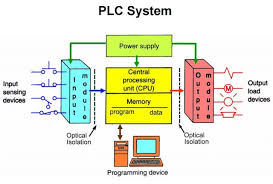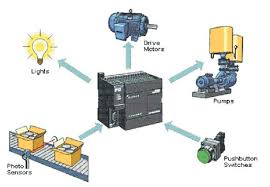Mastering Programmable Logic Controllers for Automation Excellence
In today’s fast-paced industrial landscape, automation is the cornerstone of efficiency and innovation. At the heart of this transformation lies the Programmable Logic Controller (PLC), a ruggedized computer designed to control manufacturing processes with precision and reliability. Having spent years exploring the intricacies of PLCs, I’ve come to appreciate their transformative power—not just as tools but as enablers of creativity and problem-solving in engineering.

Understanding Programmable Logic Controllers: A Foundational Insight
My journey with Programmable Logic Controllers began during a university project where I was tasked with automating a small conveyor system. Initially, the concept seemed daunting—replacing hardwired relay logic with a digital system felt like stepping into uncharted territory. However, as I dug deeper, I realized that PLCs are not just about replacing old systems; they’re about reimagining what’s possible.
A Programmable Logic Controller operates by reading inputs (like sensors or switches), processing them through a programmed logic, and delivering outputs (like motors or lights). What sets PLCs apart is their ability to adapt—through software, you can modify their behavior without rewiring hardware. This flexibility is why industries ranging from automotive to food processing rely on them. Over time, I’ve learned that mastering PLCs isn’t just about programming; it’s about understanding the process you’re controlling and anticipating its nuances.

The Evolution of Programmable Logic Controllers in Industry
The history of PLCs is a testament to human ingenuity. Introduced in the late 1960s by Dick Morley with the Modicon 084 for General Motors, Programmable Logic Controllers were designed to replace cumbersome relay panels in automotive assembly lines. Since then, they’ve evolved dramatically—modern PLCs support advanced functions like motion control, data logging, and network communication. Reflecting on this evolution, I recall a factory visit where I saw a legacy PLC from the 1980s still humming alongside a modern one with touchscreen interfaces. It was a vivid reminder of their enduring relevance.
Today, Programmable Logic Controllers are integral to Industry 4.0, enabling smart factories where machines communicate seamlessly. Their scalability—from compact units for small tasks to modular systems for sprawling plants—makes them indispensable. As someone who’s worked with both older and newer models, I’ve found that while technology advances, the core principle remains: reliability under pressure. Whether it’s a dusty factory floor or a sterile cleanroom, PLCs deliver consistent performance.

Practical Lessons from Programming Programmable Logic Controllers
One of the most rewarding aspects of working with Programmable Logic Controllers is programming them. Early on, I struggled with ladder logic, the graphical language that mimics relay circuits. But once I grasped its flow—like reading a circuit diagram—it became second nature. Over time, I’ve also explored other IEC 61131-3 languages like Structured Text and Function Block Diagrams, each offering unique advantages for complex tasks.
Here’s a table summarizing my experience with different PLC programming languages:
| Language | Ease of Use | Best Use Case | Personal Insight |
|---|---|---|---|
| Ladder Logic | Moderate | Sequential control | Intuitive for beginners but can get messy for large programs |
| Structured Text | Challenging | Mathematical computations | Feels like coding in C—great for precision but less visual |
| Function Block | Moderate | Modular and reusable code | Perfect for repetitive tasks; saves time |
Programming a PLC isn’t just about writing code—it’s about solving real-world problems. For instance, I once helped automate a packaging line where the PLC had to detect jams and halt operations safely. Debugging that system taught me the importance of testing in simulation before deployment. Many modern PLC software suites, like Siemens TIA Portal or Rockwell Studio 5000, offer simulation tools that let you test logic without risking downtime. This hands-on experience has been invaluable, reinforcing that a good programmer anticipates failures as much as successes.
Challenges and Solutions in Implementing Programmable Logic Controllers
While PLCs are powerful, they’re not without challenges. One issue I’ve encountered is integration with legacy systems. In a project involving a water treatment plant, the existing infrastructure used outdated protocols, and the new Programmable Logic Controller needed to communicate seamlessly. We overcame this by using protocol converters and carefully mapping data points—a process that required patience but paid off in reliability.
Another challenge is cybersecurity. As PLCs become networked for remote monitoring, they’re vulnerable to attacks like the infamous Stuxnet worm. I’ve learned to prioritize secure practices: isolating PLC networks, using strong passwords, and applying firmware updates regularly. These steps, though basic, can prevent costly breaches.
Here’s a table of common challenges I’ve faced with Programmable Logic Controllers and my go-to solutions:
| Challenge | Impact | Solution | Outcome |
|---|---|---|---|
| Legacy System Integration | Compatibility issues | Use protocol converters | Seamless communication achieved |
| Cybersecurity Risks | Potential system compromise | Network isolation, regular updates | Enhanced system security |
| Program Scalability | Complexity in large projects | Modular programming approach | Easier maintenance and updates |
The Future of Programmable Logic Controllers in Automation
The rise of the Industrial Internet of Things (IIoT) means PLCs are no longer standalone devices—they’re nodes in a connected ecosystem. During a recent project, I integrated a PLC with an IIoT platform to monitor machine health in real-time, using data to predict maintenance needs. This convergence of automation and data analytics is where I see PLCs heading, and it’s an exciting frontier.
Moreover, advancements like edge computing are empowering PLCs to process data locally, reducing latency in critical applications. I’ve also noticed a trend toward hybrid systems, where Programmable Logic Controllers work alongside Programmable Automation Controllers (PACs) for more complex tasks like motion control. As someone passionate about innovation, I’m eager to see how these developments unfold and how they’ll shape the skills engineers need in the coming years.
Why Programmable Logic Controllers Matter
Working with Programmable Logic Controllers has taught me more than technical skills—it’s shaped how I approach challenges. There’s a certain satisfaction in seeing a system you’ve programmed come to life, whether it’s a robotic arm sorting packages or a pump regulating water flow. PLCs embody the intersection of logic and creativity, demanding both precision and imagination.
One memorable moment was troubleshooting a PLC in a factory during a midnight shift. The production line had stopped, and pressure was high. After hours of tracing signals and rewriting logic, I found the culprit—a faulty sensor input that the PLC misread. Fixing it felt like solving a puzzle, and the gratitude from the operators reminded me why I love this field. It’s not just about machines; it’s about enabling people and processes to thrive.
Embracing Programmable Logic Controllers for Growth
In wrapping up, my journey with Programmable Logic Controllers has been one of learning, adaptation, and growth. They’re not just tools but catalysts for innovation in automation. Whether you’re a student tinkering with your first PLC or a professional optimizing a sprawling system, the principles remain the same: understand the process, anticipate challenges, and embrace the flexibility PLCs offer.
As industries evolve, so will the applications of Programmable Logic Controllers, and I’m excited to be part of that journey. My advice? Dive in, experiment, and don’t shy away from the complexities—because mastering PLCs opens doors to endless possibilities in automation.
